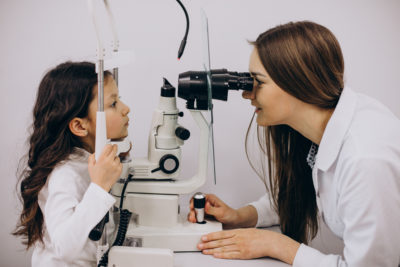Ahmad, a playful 3-month-old infant, is described by her mother, Aisha, as a happy and curious kid. Aisha spends most of her day looking after notorious Ahmad and plays various games with him to stimulate his senses and help him develop skills. When we met him the other day, his charming smile swayed us all away.
However, when we got talking with Aisha, she anxiously narrated an incident to us wherein she frequently noticed repetitive and uncontrolled involuntary movements in Ahmad’s eyes. Although, she avoided this phenomenon for a few days, thinking that it might have been just a phase, when she saw his eyes swinging more frequently, she had to take a call.

As we moved our conversation further, we found out that the symptoms that Aisha was describing pointed towards an eye condition called nystagmus. At first, Aisha got a little scared. However, when our doctors, who have been in the field for so many years, assured her that his condition could be diminished, she was relieved.
We went on to explain nystagmus to Aisha in detail:
What is Nystagmus?
Nystagmus, also known as wobbly eyes in common terms, is an eye condition wherein the patient faces involuntary eye movement. The rapid eye movement can be either from side-to-side (horizontal nystagmus), up and down (vertical nystagmus) or in a circular motion (rotatory nystagmus).
What are the types of Nystagmus?
-
Spasmus nutans
This kind of nystagmus usually occurs when a child is between 6 months and 3 years of age. However, this type of nystagmus does not require medical treatment. It improves on its own when the child reaches the age between 2 to 8 years.
-
Acquired
Acquired nystagmus often takes place in late childhood or even adulthood. The reason behind the cause of this type of nystagmus is yet unknown. Although, there are studies that claim that central nervous system or metabolic disorders could be the cause.
-
Infantile
Develops between the ages of 2 to 3 months; infantile nystagmus is often associated with other conditions such as congenital cataracts, underdeveloped optic nerves, or albinism. This is the condition that Ahmad has been facing.
After a brief discussion about nystagmus, Aisha became curious about the causes and risk factors involved in causing nystagmus.
What are the Causes and Risk Factors of Nystagmus?
The brain entirely controls eye movement. That is why the eyes automatically move when one tilts or moves their head. This process helps a person see an image more clearly. In individuals with nystagmus, the part of the brain that controls eye movement does not work properly.
While in some cases, it is difficult to figure out the actual cause of nystagmus, in other cases, they could be caused due to some other underlying eye problems.
The following is the list of some major causes for better comprehension-
-
Family history
-
High refractive error, I.e., nearsightedness
-
Albinism
-
Cataracts
-
Inflammation in the ear
-
Issues in the central nervous system
Further, we listed down the symptoms of nystagmus for Aisha.
What are the Symptoms of Nystagmus?
The major symptom of nystagmus is frequent rapid eye movements which are uncontrolled and involuntary. Other symptoms include
-
Dizziness
-
Sensitivity to light
-
Objects appearing blurry
-
Tilting head to see better
-
Difficulty balancing steps
Although our team of experts were sure about Ahmad’s condition to be nystagmus, it was important to run some thorough eye tests to be sure. We asked Aisha to bring Ahmad for some formal tests the next day.
On Ahmad’s arrival the next day, we ran him through several eye tests with our best-in-class tools and equipment made with advanced technology.
Diagnosis of Nystagmus
The diagnosis for nystagmus may include-
In the first step, it is important to determine a patient’s history and the existence of any general health problems they might have been facing.
Next, refraction testing is necessary to determine the appropriate lens power needed to compensate for the degree of refractive error.
Since, in many cases, nystagmus is caused due to some other medical conditions, our ophthalmologists might suggest you to seek other physicians or medical specialists for a neurological exam, ear exam, brain MRI, and more.
After a few comprehensive tests, we were sure that Ahmad had been suffering from nystagmus all this while. Moving forward, we told Aisha that the condition that Ahmad was going through, I.e., infantile nystagmus, cannot be entirely cured. However, with the right treatment, his symptoms can be brought down to a minimum.
Treatment for Nystagmus
Eyeglasses or contact lenses can be beneficial for people with nystagmus. Although they cannot fix the condition, having a clearer vision can slow down rapid eye movement.
Sometimes, surgery can be an option to reposition the eye muscles responsible for eye movements. This can reduce the need for the head to turn as far as to keep the eyes from moving. However, it is important to know that surgery cannot cure nystagmus; it can just help a person limit their eye movements.
We recommended Aisha to get eyeglasses for Ahmad to control and slow down the effects of his infantile nystagmus. This is because Ahmad is too young to be wearing contact lenses.
The other day we met Ahmad, who came in for his routine checkup. The little ball of enthusiasm is in the learning stage of walking with his tiny feet. His eye condition has not become a hindrance to his growth.
Seek the Best Treatment for Nystagmus and Other Eye Conditions with Dr Agarwal’s Eye Hospital
For over 6 decades, Dr Agarwal’s Eye Hospital has proven to be the best-in-class in the field of eye treatment. The combination of exceptional knowledge, experience, and modern ophthalmic technology makes our hospital safe and secure for your eyes.
Now, you can contact our senior doctors in the comfort of your home with video consultations. Explore our website to know more.










